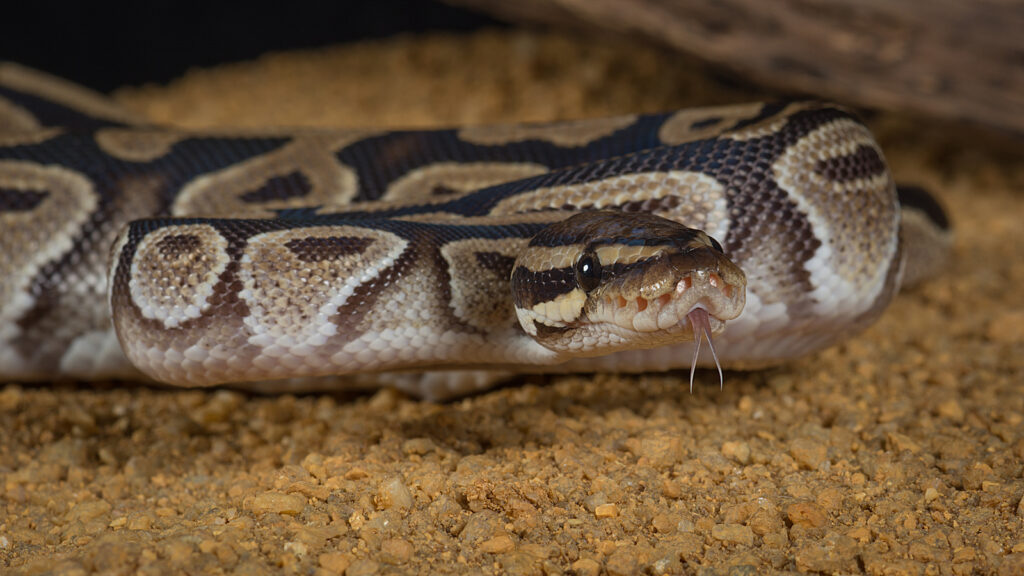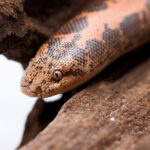If you’re interested in getting a Pastel Ball Python, it’s important to do your research and understand their specific care needs. These snakes are a popular color morph of the Ball Python species, known for their calm temperament and vibrant colors. However, they have particular requirements when it comes to husbandry, including moderate to high humidity, and are prone to health issues such as anorexia, poor sheds, impaction, and obesity.
In this complete care guide, we’ll cover everything you need to know to provide optimal care for your Pastel Ball Python. From enclosure requirements to feeding, substrate options, and common health issues, we’ll give you all the information you need to ensure your snake is happy and healthy.
Whether you’re a first-time snake owner or an experienced reptile enthusiast, our guide will provide you with the knowledge and tools you need to provide top-notch care for your Pastel Ball Python.
Table of Contents
Key Takeaways
- Pastel Ball Pythons are a popular and vibrant color morph of the Ball Python species with a calm and friendly temperament.
- They require moderate to high humidity and lots of hiding spots and coverage in their enclosure to prevent anorexia, poor sheds, impaction, and obesity.
- A basking lamp is required during the day to simulate a day-night routine, and their enclosure should be sanitized every four weeks with substrate and décor changes.
- Careful observation of their behavior, fecal habits, and body condition is crucial for catching problems early, and they can live for well over 25 years in captivity.
Facts about Pastel Ball Pythons

If you’re looking for a new pet, it’s important to know that pastel ball pythons are a color morph of the Ball Python species and are known for their friendly temperament and vibrant colors.
These medium-sized snakes are native to western Africa and are popular pets due to their calm and docile nature. Pastel ball pythons are also known for their unique coloration, which is a result of selective breeding.
The first recorded clutch of captive-bred pastel ball pythons was in 1997, and since then, they have become one of the most common morphs. Breeding habits are an important consideration for anyone considering adding a pastel ball python to their collection.
These snakes are carnivorous and constrict their prey, and they require moderate to high humidity to thrive. They also need a basking lamp to simulate a day-night routine, with temperatures ranging from 88 – 92°F at the basking surface and 76 – 80°F on the cool side.
Pastel ball pythons can live for well over 25 years in captivity, and their price range can vary from $30 – $75 depending on their color contrast. It’s important to find a reputable breeder when looking to add a pastel ball python to your collection.
Enclosure and Substrate
To properly house your new Pastel Ball Python, it’s essential to create an enclosure that provides enough space and hiding spots. A 40-gallon tank with plenty of fake foliage, sticks, and rocks is recommended to give your snake enough room to move around and hide. It’s essential to choose decor options carefully as they provide coverage and help reduce stress.
A few decor options to consider include adding branches or logs to create different levels and a more natural environment. Rocks can also be used to create hiding spots and basking areas. Additionally, it’s crucial to provide a large water dish that should be changed at least every two days.
Choosing the right substrate is also critical for promoting healthy shedding and respiratory health. Cypress mulch, coconut fiber, or fertilizer-free topsoil are the best substrate options. These substrates hold moisture well and do not cause respiratory issues. Avoid using dry or dusty substrates as they can cause respiratory problems.
It’s also important to sanitize the enclosure every four weeks, and substrate and decor should be changed. Wooden decor should be baked for 15 minutes at 350°F, while plastic decor or plants can be dipped in a 10% bleach solution and rinsed with water. By following a regular cleaning routine and choosing the right decor options and substrate, you’ll help ensure your Pastel Ball Python is healthy and happy.
Temperature and Lighting
Maintain a basking temperature of 88 – 92°F at the surface of your snake’s enclosure during the day, while keeping the cooler side between 76 – 80°F and an ambient temperature of 82 – 83°F. Temperature control is crucial to the health of your Pastel Ball Python. Use a digital thermometer to monitor the temperatures in your snake’s enclosure, and adjust the heat source as needed to maintain the appropriate temperature gradient.
In addition to temperature control, lighting schedule is also important for your Pastel Ball Python’s health. A basking lamp should be used during the day for roughly 12 hours to simulate a day-night routine. The basking lamp should maintain a temperature of 88 – 92°F at the basking surface. UVB bulbs are not required for Pastel Ball Pythons, but they can be beneficial. Use a timer to ensure that your snake receives consistent lighting and dark periods. By maintaining proper temperature and lighting schedules, you can help ensure that your Pastel Ball Python remains healthy and happy.
| Temperature | Range |
|---|---|
| Basking | 88-92°F |
| Cooler side | 76-80°F |
| Ambient | 82-83°F |
| Lighting | Schedule |
|---|---|
| Basking | 12 hours |
| UVB | Optional |
| Dark | 12 hours |
Observing Behavior and Health
Observe your snake’s behavior and health regularly to catch any potential issues early. As a responsible owner, it’s important to keep a close eye on your Pastel Ball Python’s eating habits, body condition, and shedding. Regular feeding, healthy body condition, and full sheds are great signs of a healthy snake.
On the other hand, refusing prey, stuck shed or eye caps, and wheezing or open-mouth breathing are sickness symptoms to watch out for.
In addition to monitoring their physical health, you should also pay attention to their behavior. Pastel Ball Pythons are not always fond of being handled, especially if they feel stressed or uncomfortable. It’s important to build trust with your snake by using scent, and allowing them to explore their environment on their terms.
If your snake is balling up or showing signs of aggression, it’s best to give them space and try again later. By being patient and observant, you can develop a strong bond with your Pastel Ball Python and ensure they live a happy, healthy life.
Frequently Asked Questions
What are some common health issues that Pastel Ball Pythons may experience?
Common health issues for Pastel Ball Pythons include anorexia, poor sheds, impaction, and obesity. Preventative measures include proper humidity and diet. Treatment options depend on the specific issue and may require veterinary care.
How often should the water dish in the enclosure be changed?
To maintain water dish hygiene, change the water at least every two days. Unclean water can lead to bacterial and fungal growth which can negatively impact pastel ball python health. Regular cleaning and misting are crucial to their well-being.
What are some ways to build trust with a Pastel Ball Python?
To build trust with your Pastel Ball Python, use training techniques such as scent and handling methods like frequent, gentle handling. Patience and consistency are key in creating a bond with your snake.
Are UVB bulbs necessary for Pastel Ball Pythons?
UVB bulbs are not necessary for Pastel Ball Pythons. However, there are alternatives like basking lamps and other lighting options that can provide the necessary heat and light. It’s important to maintain proper temperature and lighting for their health.
What is the typical lifespan of a Pastel Ball Python in captivity?
You’re probably wondering about the lifespan of a Pastel Ball Python in captivity. With proper care requirements, you can expect your python to live well over 25 years. Keep an eye on their behavior, sheds, and body condition to ensure a long and healthy life.
Conclusion
Congratulations on taking the first step towards providing optimal care for your Pastel Ball Python! By following the guidelines outlined in this complete care guide, you’ll be able to create a comfortable and healthy environment for your new pet.
Remember, keeping a Pastel Ball Python is a commitment, and it’s important to be dedicated to their care needs. With proper enclosure and substrate, temperature and lighting, and observing behavior and health, your python can thrive in their new home.
Think of it as creating a cozy and inviting atmosphere for your guest – just like how you would adjust the temperature, lighting, and cleanliness for a friend visiting your home.
One helpful tip is to observe your python’s behavior and adjust their care as needed. Just like how you would adjust the temperature in your home if your guest was too hot or too cold, you can make changes to their enclosure if your python is exhibiting signs of stress or discomfort.
By keeping a close eye on their behavior and health, you’ll be able to address any issues before they become serious.
Overall, taking care of a Pastel Ball Python can be a rewarding experience, but it requires effort and dedication. With the right care and attention, your python can live a long and healthy life in their new home. So, get ready to welcome your new scaly friend and create a cozy and comfortable space for them to thrive!




